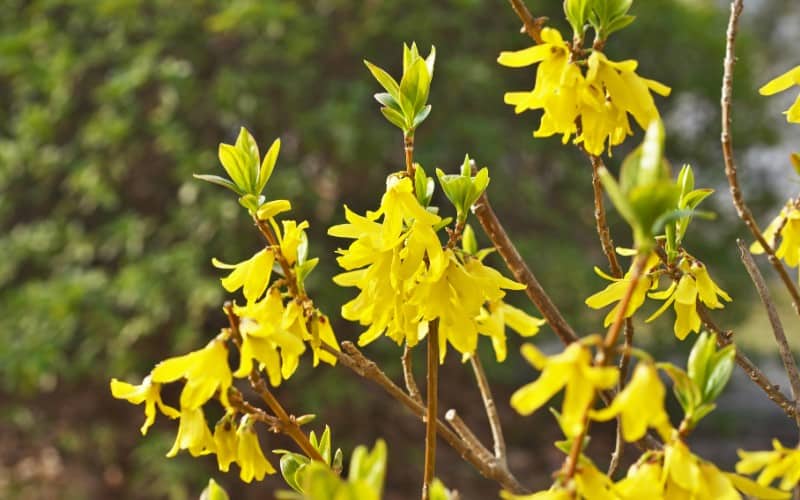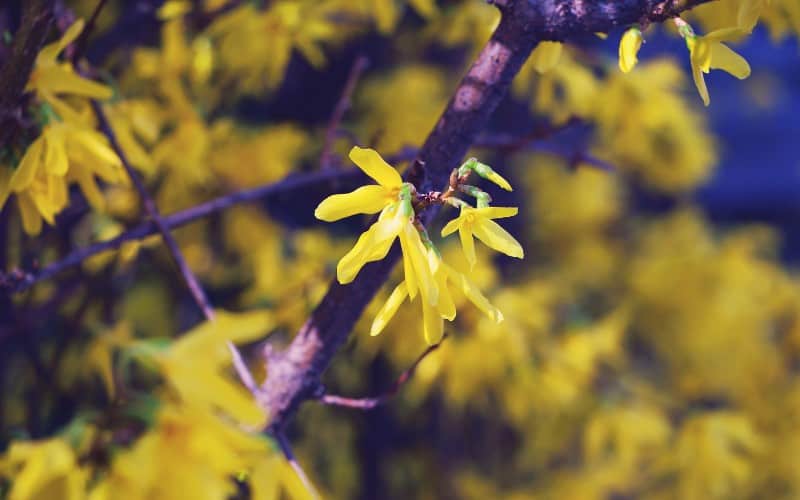The Forsythia flower makes a colorful add on a spring landscape; its yellow flower bloom in early spring gardens serves as the first sign of spring.
The Forsythia shrub is versatile, loved, and widely planted by all because of its many virtues – it requires basic knowledge to plant, it’s fast-growing, tough, and easy-to-cultivate. Although it has all these beautiful features because of its fast-growing nature, the Forsythia flower tends to overgrow.
It spreads in an unkept fashion, making it look a little over the mess and triggering gardeners to over trim, which sometimes leaves them with an over pruned Forsythia with no blooms.
Now, if you're wondering when to prune Forsythia to maximize their benefits, then it's recommended to prune Forsythia shortly after it has finished blooming on old wood.
It is simple, to get that well-shaped shrub with all its benefits it’s important to trim forsythia bushes at the right time.
What is Forsythia?

The first sight of the cheery yellow blooms on the stems of a perennial forsythia plant is one thing that always gets gardeners anxious and eager as they await full spring so they can start gardening again.
During springtime, the ever colorful forsythia plants elude its brilliant yellow flowers that blend well with the sunlight, this mixture of color bursts reflects perfectly on the northern winter landscape.
Forsythia is a flowering shrub, with its cheery yellow flowers that make the most beautiful in the spring landscape also their hardy and easy to grow nature, makes them one of the first plants to bloom every year.
The long branches grow out with small yellow flowers, welcoming in the spring with a ray of colors.
Many gardeners and homeowners buy a forsythia daydreaming about the burst of colors that will pop in their garden beds during early spring.
So you plant it at your favorite spot, door, window, or passageway where you can easily see it in full bloom. Some years later it has overgrown into a 10-foot tree plant that leaves you struggling to find your way. And now you are left asking when to prune Forsythia for a better-shaped form without butchering it?
Fret not, if you don’t know how to prune forsythia bushes, you aren’t alone. One of the factors that make it challenging to figure out when to prune Forsythia is because the flowers of the perennial come before the leaves.
So how do you keep the growth of this vigorous perennial in check without chopping into pieces and risk not having blooming flowers all year round?
- Read Also: When to Prune Pyracantha Plant
When to Prune Forsythia

One of the most loving features of Forsythia is its bright yellow flowers. Although small in inches, a combination of all its flowers makes up for a display of stunning show in the early spring.
After the spring you notice small green leaves emerging to fill in the void of the flowers after they fade away and the petals fall to the ground.
The Forsythia is an enthusiastic fast-growing plant, so its shrubs and branches can grow naturally to a height of 10 feet and spread widely twice that number without interruption. So a yearly pruning and trimming help to keep the size and shape of the plant in check.
However, from the onset, some growers start at the wrong foot with Forsythia by planting them in the wrong spot. As fast-growing plants, the forsythia plant should be grown in areas that can accommodate them and give enough room for proper growth. So before pruning Forsythia, it’s essential to get the planting right also.
So when is the best time to prune these shrubs?
Pruning forsythia should not cause too much stress and worry because it is such an easy-going and fast-growing shrub, so its pruning errors are hardly permanent and can be corrected in the following years of new growth. However, pruning will be most beneficial to the plant when it’s done at the right time.
The usual gardening advice recommends to prune forsythia shrubs shortly after they finish blooming on old wood, so if you prune before the blooms appear, you won’t have any flowers that current year. The best practice is aligning the timing of your pruning based on what results in your desire to accomplish.
If you’ve been keeping the shape of the plant regularly and it’s looking good, then you should go ahead and prune after flowering in the spring. Wait for a little for the yellow flowers to fade and for the new leaves to grow before pruning.
But for rejuvenation pruning which is a good idea if the shrub is large and unkept and you want to control it back, you may prune using a gardening pruner in the summer, fall or winter when the plant is still dormant.
Though the number of springtime flowers you will see for next season will be sacrificed and your plant may yield less in the next season, but the result is usually a well-structured, good looking and tamed Forsythia.
It is best to bypass your Forsythia when the plant is 1-3 years old. Young forsythias need little to no pruning so avoid it for now so the plant can naturally take shape and establish a healthy root system.
Only when they reach maturity, then you’re allowed to prune them once a year. Letting the plant take its natural shape helps it establish a healthy root system.
When pruning the mature forsythias, it’s advisable to remove a quarter of the largest (oldest) stems by cutting them at ground level annually to give way for new shoots to grow and bloom the following years.
- Read Also: When to Prune Hydrangea Plant
Conclusion
Forsythias are enormous shrubs with brilliant yellow blossoms that sprout in the early springtime. When pruning, intend to give each stem heaps of room as it develops. If you prefer your plant to develop many blossoms, prune it in the springtime after it sprouts.
On the off chance that you need to control an overgrown forsythia and don’t mind sacrificing its flowers, prune it in the late spring, fall, or winter. Prune your forsythias once per year, so your plants remain naturally strong and healthy.




